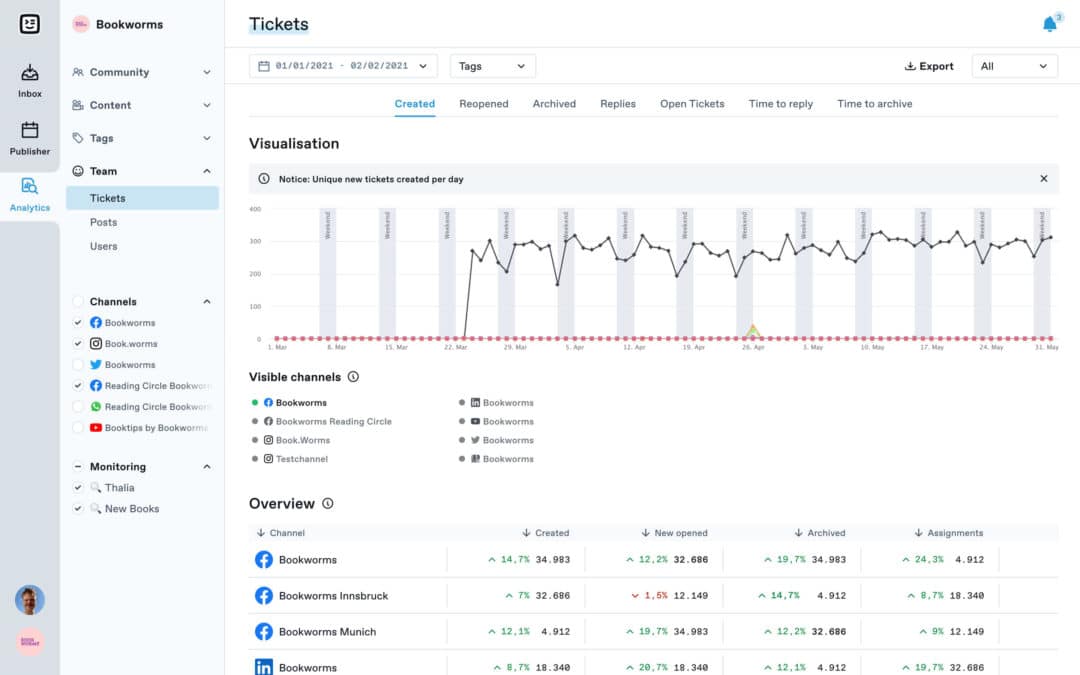
How to Convince Your Managers and Colleagues of the Value of a Social Media Tool
So you want to harness the power of a good social media management tool in order to save time, streamline your processes, and interact more effectively with your target audience, but there’s just one snag: First, you need to convince your supervisors and/or colleagues that purchasing one will be worth it. After all, social media tools not only cost money but also require a willingness to let go of old processes and embrace new ones.
These are two of the reasons why some executives initially pooh-pooh the idea. Besides, social media marketing can be done directly on Facebook, Instagram, and LinkedIn, can’t it?
In this article, we will be offering some fantastic tips to help you persuade stakeholders to invest in a social media management tool. By exploring how this sort of tool can benefit different areas of the company and highlighting some effective communication strategies, we will equip you with some solid arguments to win them over. We will also tackle the issue of onboarding.
The Benefits for Different Areas of the Company
Using a Social Media Tool for Customer Service
Studies show that:
- Younger people in particular like contacting businesses via social media.
- Customers expect faster and faster responses.
- No-hassle customer service plays a key role in securing customer loyalty.
A social media management tool makes it easier to meet these expectations. That’s because it provides a single inbox for receiving all inquiries and comments from linked profiles. Customer service staff can have the tool assign these to them automatically, so they no longer have to jump around from one platform to another. What’s more, text modules can be created to respond to FAQs. AI tools open up even more possibilities.
The key benefits are:
- No more missed messages
- Shorter response times
- Less effort for routine tasks
- More time for what really counts
The monitoring capabilities even allow customer service staff to proactively engage with their target group, thereby increasing customer satisfaction.
Another argument that often convinces managers is that a social media tool allows customer service teams to collect and evaluate valuable data. This provides them with answers to questions such as “How long on average does it take to get an answer?” or “Who are the people actually contacting us on Facebook?”

Using a Social Media Tool for HR
If you are looking for fresh faces to join your company, a social media management tool can get you ahead in the “war for talent”.
- A consistent image: A dashboard allows the HR team to run employer branding campaigns on LinkedIn, Facebook, Instagram, and other channels. This makes it easier to coordinate content and create a harmonious image.
- Address a specific target group: Precise targeting enables you to reach exactly the right professionals with content or job advertisements, for example.
- Valuable insights: Recruiters gain insights into what job seekers think about the company, what they expect from a job, and how they respond to recruitment campaigns.
- Encourage employee retention: Finally, social media helps to retain employees. For instance, a good tool makes it easier to turn employees into brand ambassadors.
Using a Social Media Tool for Marketing and Sales
It is often the marketing team that first comes up with the idea of using a social media tool. However, you might still need to persuade colleagues from your department by using arguments such as the following:
- More efficient social media marketing: If you are already taking your social media marketing seriously, a social media tool will make your job much easier. Instead of having to log into platforms individually, for example, you can plan your content well in advance and have it published automatically. And if your social media channels have been just sitting there gathering dust, a good tool is the perfect way to get started.
- Increase your reach and brand awareness: A social media management tool makes it easier to run more channels with high-quality content tailored to the needs of your target group and to stay in touch with your communities. This in turn increases your reach and brand awareness.
- Effective lead generation: Generating leads becomes easier thanks to tools such as a central ticket inbox, analytics, and integrated customer relationship management.
- Valuable insights for campaigns: Cross-channel analyses provide valuable key ratios that you can use to refine your marketing actions and tailor them to different target groups.
All of this also helps the sales team hit their targets. While on the subject of sales, questions about products, for example, can be answered more quickly and easily by integrating sales staff into your social media tool.
Using a Social Media Tool for Product Development
Are your colleagues from product development finding it difficult to keep up with the latest trends and the wants and needs of their target group?
If so, a social media tool featuring monitoring and listening functions will make their life much easier. That’s because it allows you to track and evaluate conversations about your own brand and products, as well as competitors, industry topics and plenty more besides, even if these conversations do not actually take place within your own profiles. As a result, your product development colleagues will be able to find out what makes their own target group tick and which features of their products hit the mark or could be improved.
They will also get ideas for developing new products.
Want an example?
The ice cream brand Ben & Jerry’s was surprised to see stronger sales in bad weather than when the sun was shining. Thanks to social listening, they were able to find out why. On rainy days, many fans of the brand love nothing better than to sit or lie in front of the TV with a tub of ice cream.
And with that, a new variety of ice cream was born:
The Benefits for Crisis Management
Some of the benefits offered by social media management tools are relevant to multiple – if not all – areas of the company.
These include the issue of crisis management. Today, there is a greater risk than ever of a careless statement or an awkwardly worded campaign slogan unleashing a firestorm on your company.
Although social media can have an amplifying effect in this regard, it also enables you to spot the signs of an impending crisis before it is too late. With a social media tool, you can scan platforms for complaints and keep an eye on how people feel about your brand and products. This means you have an opportunity to preempt the situation – by making an apology, for example:
We apologize to the two individuals and our customers for what took place at our Philadelphia store on Thursday. pic.twitter.com/suUsytXHks
— Starbucks (@Starbucks) April 14, 2018
Strategies to Convince Others of the Value of a Social Media Management Tool
You’ve got some good arguments to use now. But sometimes these are not enough.
This brings us to the strategic part of this article, which is intended to answer the following question: “How do you communicate the benefits of a social media management tool persuasively?”
Cite Data
Numbers say more than words, especially if you want to persuade a supervisor or the purchasing department to make an investment. Calculate how much time a social media tool would save in the context of customer service or when planning content.
Outline how many platforms and conversations a tool can keep scanning for any relevant updates. Look for meaningful statistics. The more accurate they are, the better.
Consider the well-known metric of return on investment (ROI); what matters is the end result.
Drip Feed Your Arguments
It is often better to spread arguments over a longer period than to drop them all at once. Start by offering a few figures, then give them a success story or explain how tricky it is to track key ratios – that’s how to make a topic stick in people’s minds.
Share Some Success Stories
Maybe a competitor bought a social media tool and has since managed to attract a few hundred extra followers. Or perhaps you’ve read an interesting social media case study where monitoring provided the crucial idea for a top-selling product. If so, share this information with your managers.
Find Supporters
Chances are that there are others in your company who are in favor of introducing a social media tool. Join forces with them. This will allow you to communicate the benefits together.
Suggest a Pilot Project
Providers of social media management tools know that potential customers like to try things out before they commit. For this reason, they usually offer free demos. Urge your boss to take advantage of this offer or to run a temporary pilot project. That way, the team won’t be plunging in at the deep end.
Tips for Onboarding a Social Media Tool
Assuming that your arguments have fallen on fertile ground, you should now seize the opportunity and ensure that the introduction of the social media management tool goes without a hitch. If everything goes smoothly, there is a good chance that no one will want to go back to how things were before.
Use the following strategies for the onboarding process:
- Identify in advance exactly how the tool works. Find out whether and how the provider will help with the onboarding process.
- Formulate clear objectives for using the tool. What does each department want to achieve with it?
- Organize workshops and training sessions. Provide employees with a point of contact for questions.
- Gather regular feedback. What further information is needed? What questions come up time and again? Does the tool have any vulnerabilities that you haven’t considered?
Skillful Communication is Key
There are lots of good reasons why virtually every company that is serious about social media marketing insists on using a social media management tool. Just in case there is any doubt, these factors are also bound to apply at your company.
But if you want to persuade critical stakeholders to invest in one, you should define and formulate these benefits as clearly as possible. Back them up with data, join forces with other people to present them, and skillfully drip feed your arguments. Take advantage of opportunities for pilot projects and ensure an efficient onboarding process. This will increase the chances of winning over the decision-makers.
Once the decision has been taken to use a social media tool, all you need is the right one. Swat.io can utterly transform your social media marketing. Start a free trial now!
 29. May 2024
29. May 2024 








